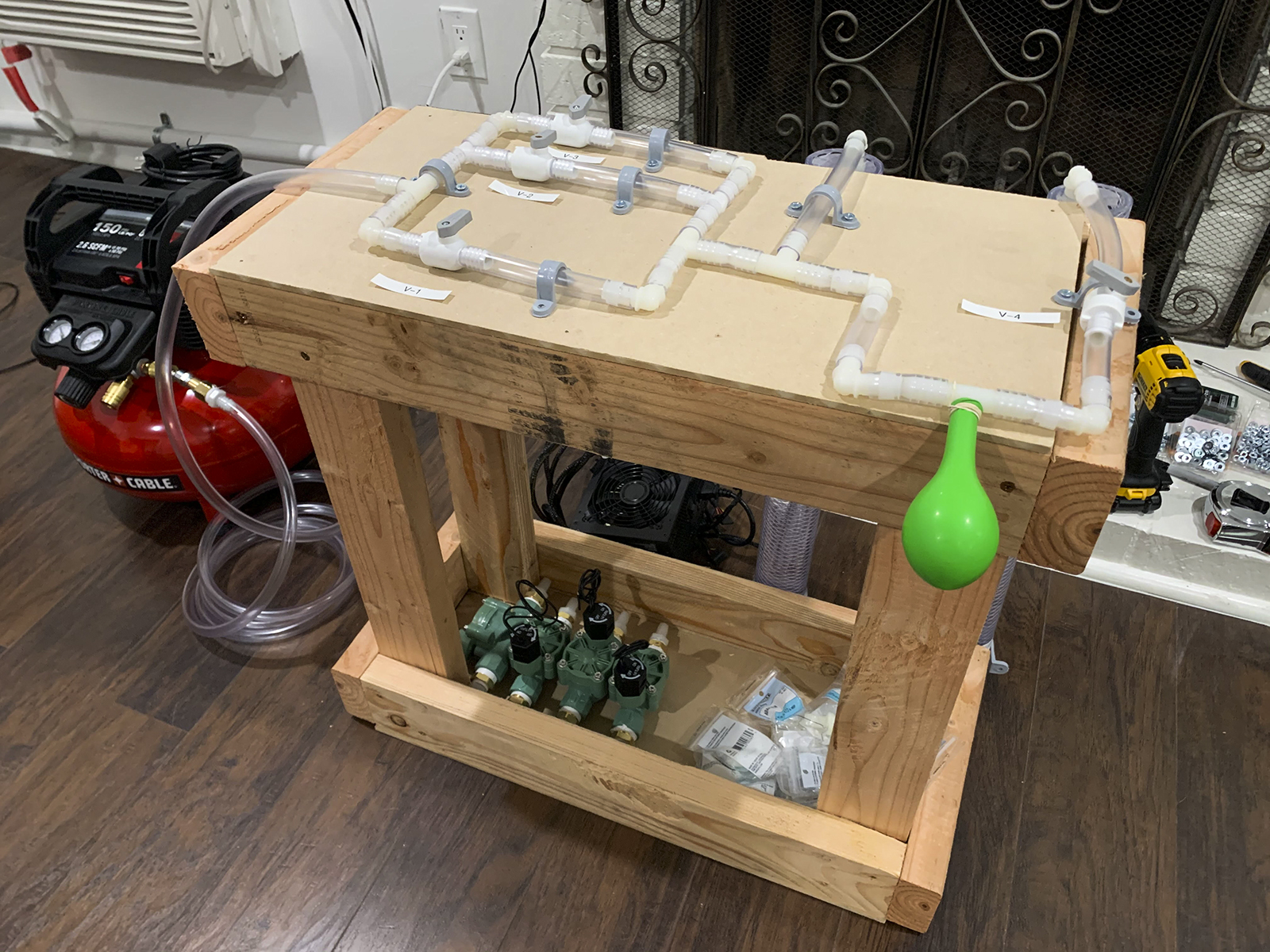Graduate student breathes new life into ventilator-building process with prototype

In light of a COVID-19-induced national shortage of ventilators, UCLA graduate student Glen Meyerowitz began developing a cost-effective prototype, assembling a model within a week. (Courtesy of Glen Meyerowitz)
By Keaton Larson
April 24, 2020 12:34 p.m.
A UCLA student is developing a low-cost ventilator to help fight COVID-19.
Graduate student Glen Meyerowitz saw the need for ventilators across the country and knew he could create a dramatically simplified, cost-effective ventilator to address the problems specific to the new coronavirus. He spent five years at SpaceX testing rocket propulsion and spacecraft systems before coming to UCLA to study electrical and computer engineering.
All within one week, he consulted with clinicians, developed a design for the ventilator, bought the parts from Home Depot and completed a functional device. Meyerowitz is a future fellow in the UCLA Biodesign program, which seeks to transform medicine and healthcare through new technologies.
Ventilators currently available are not cheap, with the average model for intensive care units costing tens of thousands of dollars, Meyerowitz said. These ventilators are built to tackle any problem a doctor could face when treating a patient, Meyerowitz said.
Meyerowitz focused on a simpler design for his ventilator to cut down costs and make it easier to use. He hopes the final design will cost between $1,000 and $3,000.

His ventilator is also much simpler to build, which means more can be produced in a shorter time span compared to those produced by major manufacturers.
Meyerowitz initially reached out to Jennifer McCaney, the co-executive director of the Biodesign program, and Desert Horse-Grant, the senior director of innovation and research at UCLA Health and a co-executive director of the Biodesign program, about his idea for a simplified ventilator.
“When (Meyerowitz) came to (Horse-Grant) and I with the prototype, he was seeking resources, mentorship and help catalyzing this from a benchtop idea or a concept to preclinical and beyond,” McCaney said. “We were able to quickly catalyze and mobilize the Biodesign network to help him move the project ahead quickly.”
Mathew Savary, the principal of the UCLA Innovation Fund and New Ventures at the UCLA Technology Development Group, played an integral part in managing the project as well.
The UCLA Technology Development Group works to advance innovation, entrepreneurship and research in startups, new inventions and the commercial operations involved in these projects.
By complete coincidence, Savary reached out to McCaney with his concerns about the availability of medical resources and the complex and long manufacturing process of ventilators currently on the market.
McCaney connected Savary with Meyerowitz, and the two began working together.
“(Meyerowitz) has been doing the lion’s share of the heavy lifting on navigating this project forward,” Savary said. “I’ve been trying to help shepherd him through the process of building appropriate design requirements, and then we’re going to be moving toward trying to get this manufactured and some money raised.”
Soon after Meyerowitz and Savary connected, a team of engineers, clinicians, researchers and entrepreneurs from UCLA and around the country formed a nonprofit called Ventlife, based around Meyerowitz’s prototype.
Meyerowitz contacted clinicians fighting the pandemic on the front lines to understand how ventilators are used, the problems they are seeing in hospitals and specific issues related to treating patients with COVID-19.
He noted four key components of a ventilator that clinicians labeled as necessary when trying to treat a patient with COVID-19: the ability to control the amount of air that is pushed into a patient’s lungs during each respiratory cycle, the rate with which air is pushed into the lungs, the pressure in the lungs and the fraction of expired oxygen.
“Typically, air has 21% oxygen, but for certain cases, you might want to go up to 100% oxygen for short times if a patient is not getting enough oxygen in the lungs,” Meyerowitz said.
Recently, Meyerowitz has spent time at the UCLA Simulation Center, which owns an artificial lung. By connecting his prototype to the lung, Meyerowitz is able to get data on how the device is working.
“That’s really important in terms of validating how well the device performs, seeing issues and determining areas where it needs to be improved,” he said.
Assuming there are no large changes made to the ventilator, Meyerowitz and the Ventlife team will focus on finalizing the design and then partnering with medical device manufacturers that have certifications with the Food and Drug Administration to produce products that will get approved.

“For how long will it take for us to scale up, if we were to get the money, which is still a big if, we think we could be there in several months from now,” Meyerowitz said.


